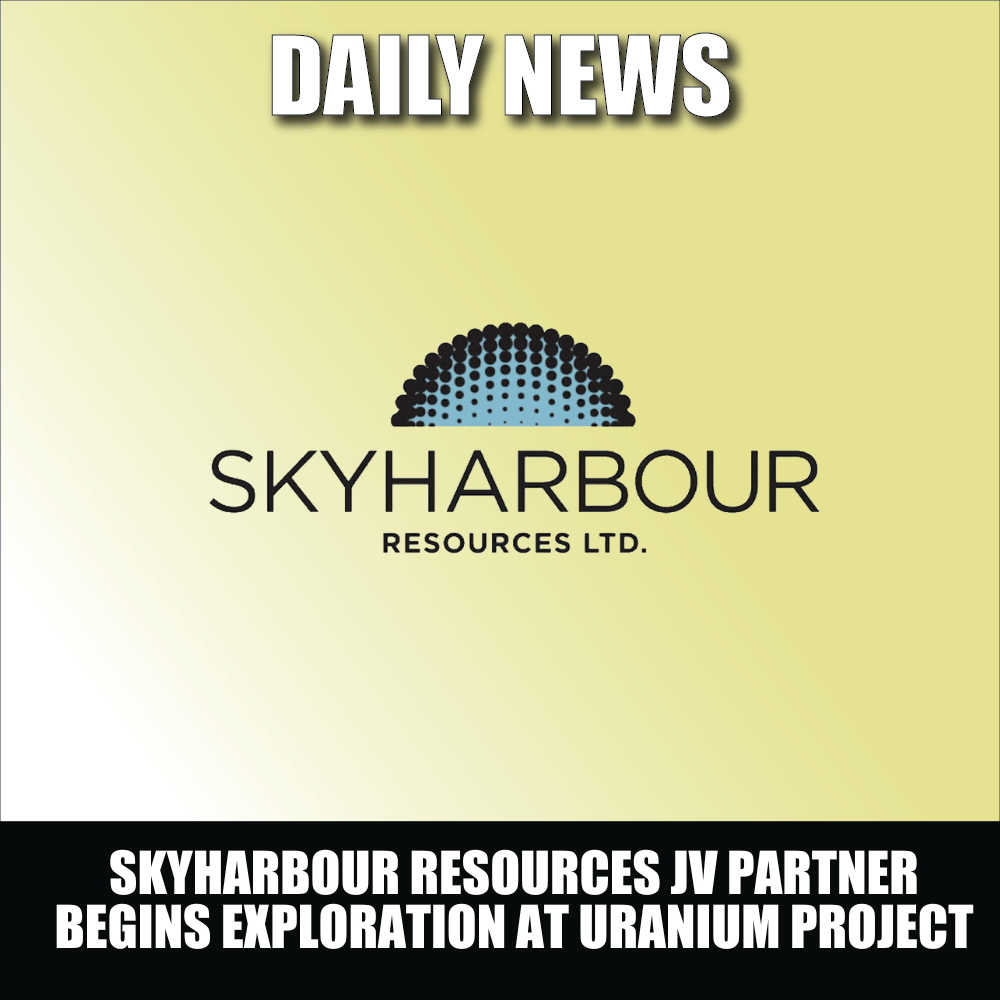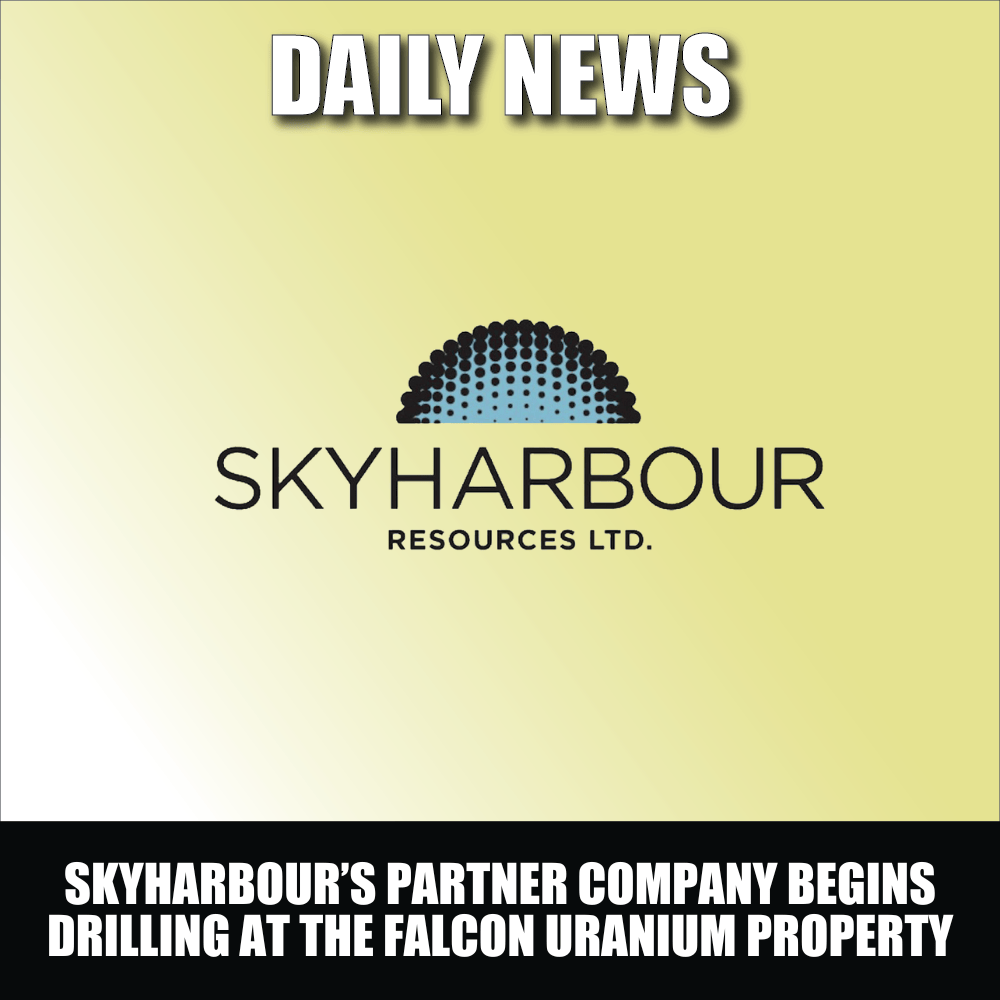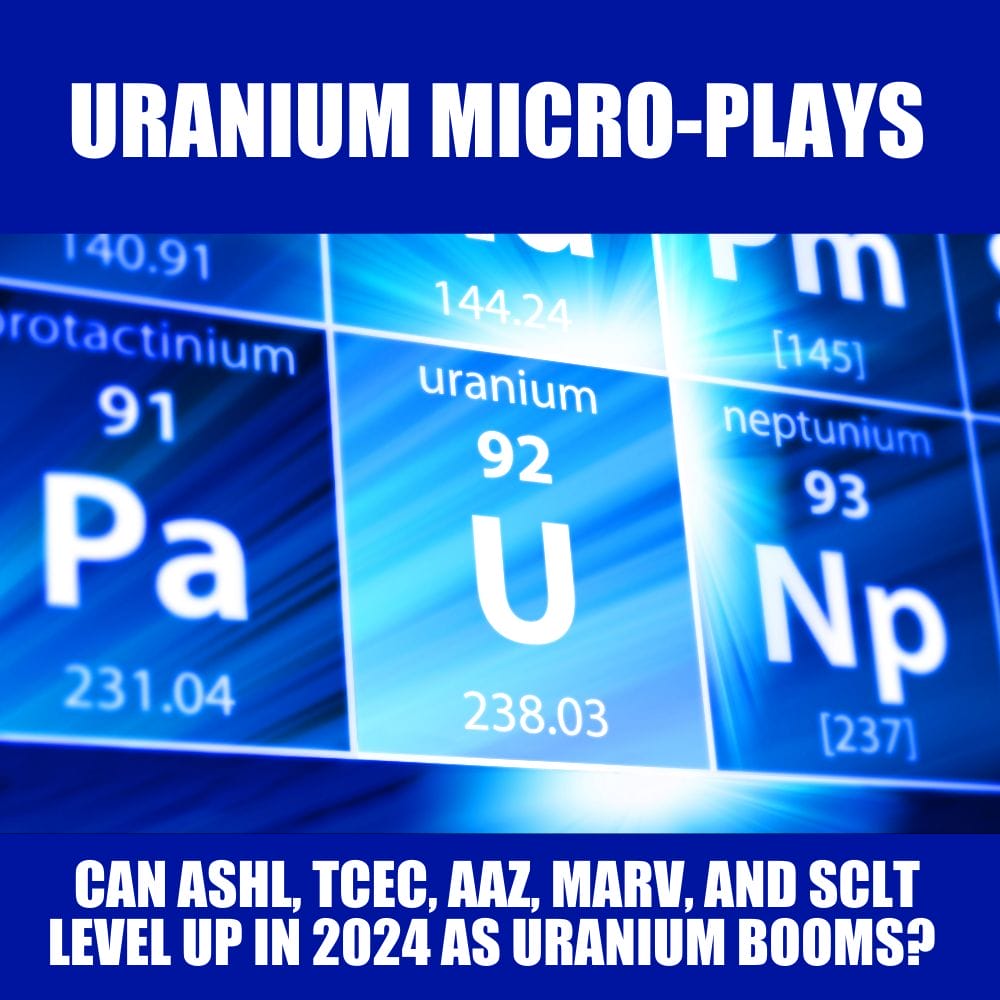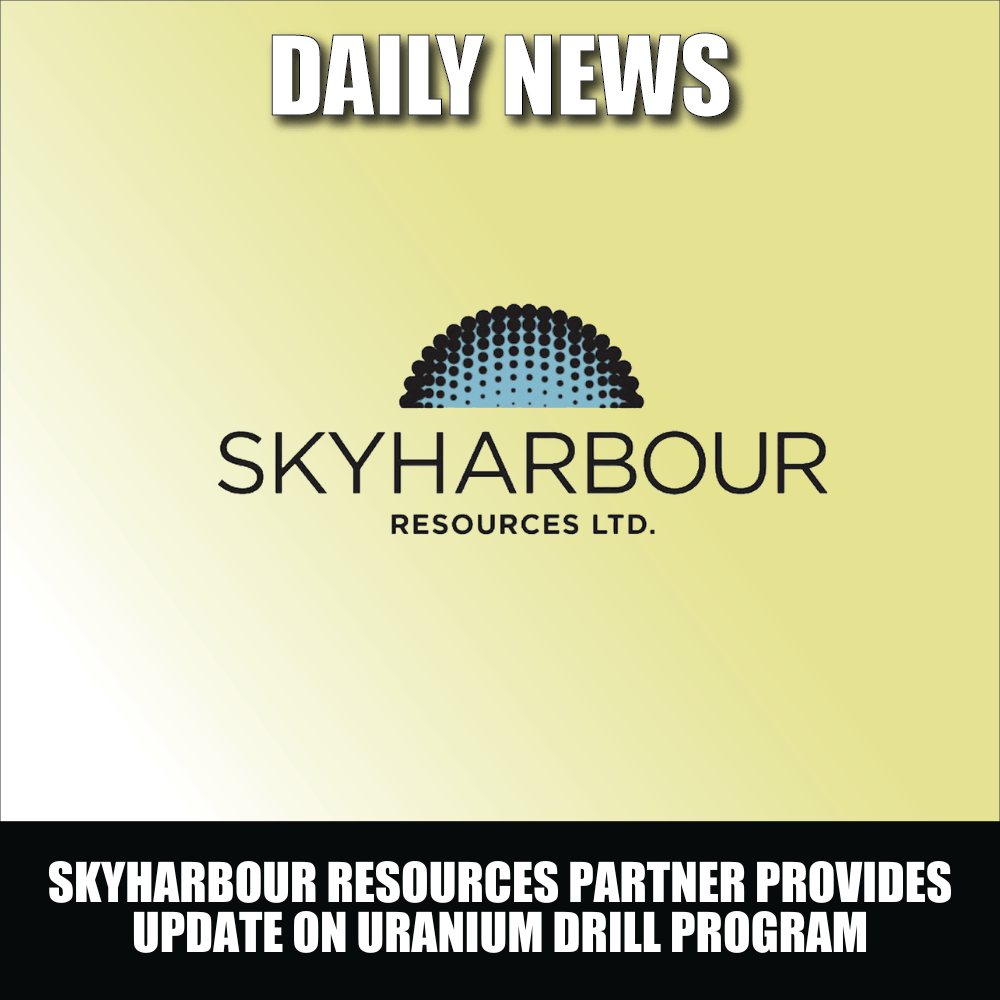Skyharbour Resources (SYH.V) recently joined the Guru fray and we marked the occasion with an in-depth write-up—Skyharbour Resources (SYH.V) an Athabasca Basin Uranium gem in the midst of an aggressive drill campaign
Earlier this am the Company dropped a weighty piece of news, announcing an acceleration in its drill campaign at Moore Lake.
The 35,705 hectare Moore Lake Uranium Project, on the southeast side of the prolific Athabasca Basin, is the Company’s flagship.
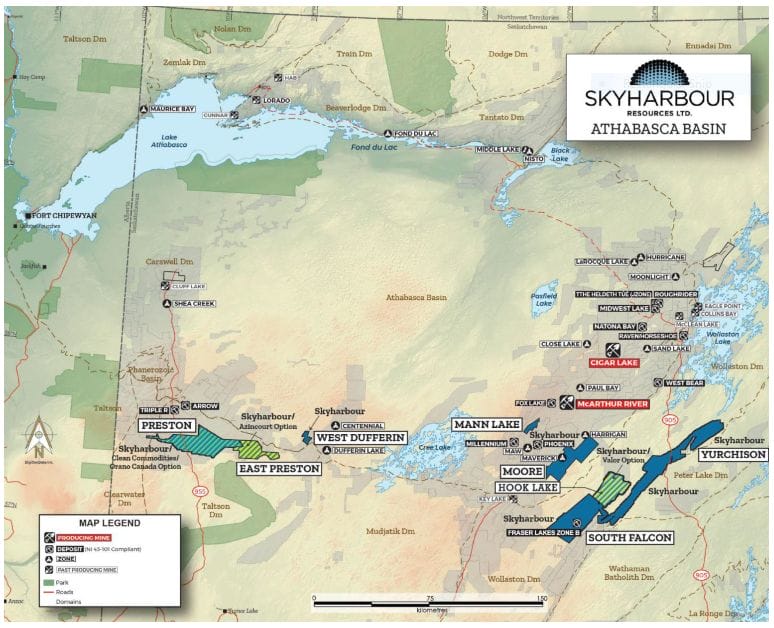 Located approximately 15 kilometers east of Denison Mine’s Wheeler River project (Denison is a strategic partner in cash-rich Skyharbour), Moore Lake is positioned in a region humming with activity—a region rich in infrastructure.
Located approximately 15 kilometers east of Denison Mine’s Wheeler River project (Denison is a strategic partner in cash-rich Skyharbour), Moore Lake is positioned in a region humming with activity—a region rich in infrastructure.
The June 16th headline…
Skyharbour Expands its Current Drill Program at its High Grade Moore Uranium Project, Saskatchewan
Here, Skyharbour announced that its drilling program at Moore Lake is progressing well and has produced sufficient encouragement to warrant an acceleration in the current campaign. I’m guessing the onsite geos like what they’re seeing coming out of the ground—they like the core.
This current phase of drilling has been expanded from 3,500 meters to 5,000 meters in 12 to 14 holes.
This fully-funded program is following up on existing unconformity and basement-hosted targets along the high-grade Maverick structural Corridor, and will probe newly defined targets along the Grid Nineteen area.
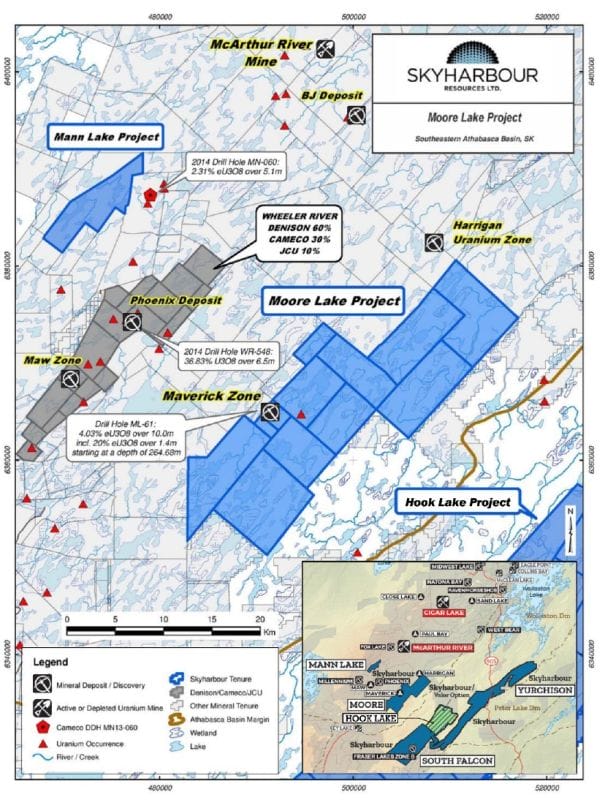 “The Company specifically plans to expand the high-grade mineralization discovered recently at the Maverick East Zone, along strike, down-plunge and at depth with a focus on both unconformity- and basement-hosted mineralization. Other targets along the 4.7 km long Maverick structural corridor will also be investigated, including the Esker Target, again with a focus on both unconformity- and basement-hosted mineralization.”
“The Company specifically plans to expand the high-grade mineralization discovered recently at the Maverick East Zone, along strike, down-plunge and at depth with a focus on both unconformity- and basement-hosted mineralization. Other targets along the 4.7 km long Maverick structural corridor will also be investigated, including the Esker Target, again with a focus on both unconformity- and basement-hosted mineralization.”
Grid Nineteen, located between the Raratonga and East Venice conductors, was the focus of a geophysical campaign earlier this spring where Skyharbour completed a 9 line-km SML-EM survey. Several high-priority targets were generated from this effort and will receive a proper probe with the drill bit during this current round of drilling.
 Maverick East Target:
Maverick East Target:
The high grade Maverick East Zone has been identified over a minimum of 170 metres strike length. It is currently a minimum of 10 metres wide, open down dip and is up to 17.9 metres thick with grades of up to 9.12% U3O8 (with a minimum grade of 0.1% U3O8). The mineralization is accompanied by intense clay alteration and geochemical enrichment of pathfinder elements such as B, Ni and Cu, with the localized high grade uranium mineralization extending from the unconformity into the basement rocks. The mineralized zone appears to plunge moderately to the northeast, with minimal drill testing at depth along plunge. In the eastern extent of the Maverick East Zone, copper values of up to 2.3% Cu along with up to 0.076% U3O8 were obtained from graphitic, clay-rich fractures within a broader zone of uranium-enriched and clay-altered granitic pegmatite and granite nearly 100 metres below the unconformity. This may be an important vector for additional basement-hosted mineralization. Some of the most significant drill hole intersections in the Maverick East Zone include ML-202, which returned 1.79% U3O8 over 11.5 metres, including 4.17% U3O8 over 4.5 metres and 9.12% U3O8 over 1.4 metres, as well as recently announced hole ML20-09, which returned 0.72% U3O8 over 17.5 metres from 271.5 metres to 289.0 metres, including 1.00% U3O8 over a 10.0 metre interval in the basement portion of the interval (279.0 metres to 289.0 metres). The focus for drilling in this area will be on the down-dip, along strike and down-plunge extensions of the Maverick East target.
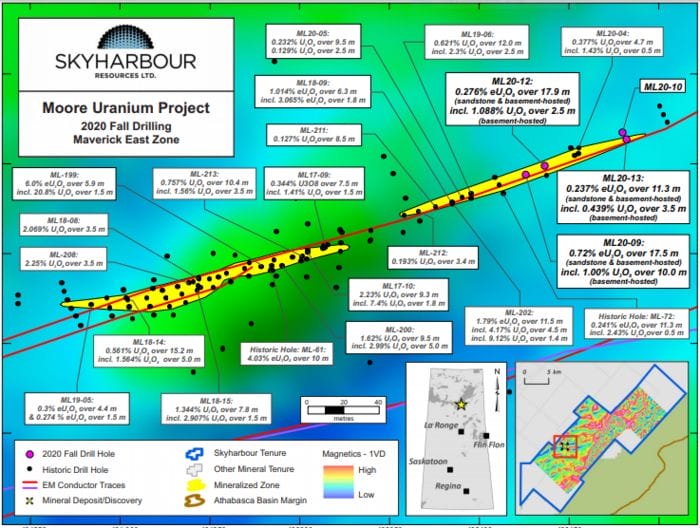 Worthy of consideration, a 1% U3O8 grade is (roughly) equal to…
Worthy of consideration, a 1% U3O8 grade is (roughly) equal to…
- 13.9 g/t Gold
- 855 g/t Silver
- 12% Copper
- 33.3% Zinc
Maverick Structural Corridor – Northeast Extension and Esker Targets:
There’s 2.2 kilometers of (largely) untested ground to the northeast of the Main Maverick and Maverick East mineralized zones. Though previously poked by a series of broadly spaced drill holes and fences, there remain significant undrilled gaps. Virtually all these widely spaced holes exhibited extensive sandstone and basement alteration, along with geochemical enrichment similar to that of the Main Maverick and Maverick East zones.
“As well, narrow intercepts of uranium mineralization have been found in numerous locations along this portion of the Maverick corridor. Many of these mineralized intercepts occur at the unconformity, but in a few key areas significant strongly altered basement structures within prospective graphitic and metasedimentary units are the host for this mineralization, with only limited drilling of the basement rocks at depth.”
The Esker Target lies at the northeastern limits of the Maverick Structural Corridor. Of note from historical drilling in this area is the anomalous uranium in drill hole MT-04, which returned up to 170 ppm U in the basal 3.0 metres of sandstone and up to 343 ppm U in the top 5.5 metres of the basement rock. The uranium is accompanied by anomalous amounts of pathfinder elements including Ni, Co, Cu, Pb, and Zn. Follow-up of the anomalous uranium mineralization has been limited with the next closest hole MT-10 (also with anomalous U in the sandstone) located 120 metres to the south. Further south in the Esker area, weak uranium mineralization was also intersected in historical holes ML-165 (1.0 metre of 0.307% U3O8 from 291.85 metres to 292.85 metres), ML-169 (1.5 metres of 0.070% U3O8 at 287.25 metres to 288.75 metres), and ML-171 (0.5 metres of 0.160% U3O8 from 296.2 to 296.7 metres). Drilling will follow-up on the anomalous uranium encountered in historical holes MT-04 and MT-10 and along trend which has only had very limited investigation to date.
Grid Nineteen Geophysical Program:
A review of historical airborne EM identified several conductive features in an area located between the East Venice and Raratonga conductor systems that warranted follow-up groundwork. The airborne conductors lie in a structurally complex area that bridges a break in the east trending East Venice conductive system and the north trending Raratonga conductors. A total of 9 line km of survey was completed utilizing 200 metre loops in a moving array. The program was designed and has been interpreted by Bingham Geoscience of Saskatoon and was completed by Patterson Mining Geophysics of La Ronge.
The preliminary results from the ground geophysical survey further refined the historical airborne conductors in the Grid Nineteen area and confirmed the extension of the Raratonga conductive system to the south. The survey further defined the abrupt change in the strike of the conductive systems at the southern end of the Grid Nineteen area, from an almost north-south orientation of the Raratonga conductors to the east-west orientation of the East Venice conductors. Weak basement-hosted mineralization was intersected in hole ML17-04 (1.0 m of 0.094% U3O8 at 235.0 metres depth) just to the west of this strike change, along with strong structural disruption and local pathfinder element enrichment in the sandstone of both ML17-04 and follow-up hole ML18-01. The intersection of these conductive systems forms one of several newly developed targets in the Grid Nineteen area.
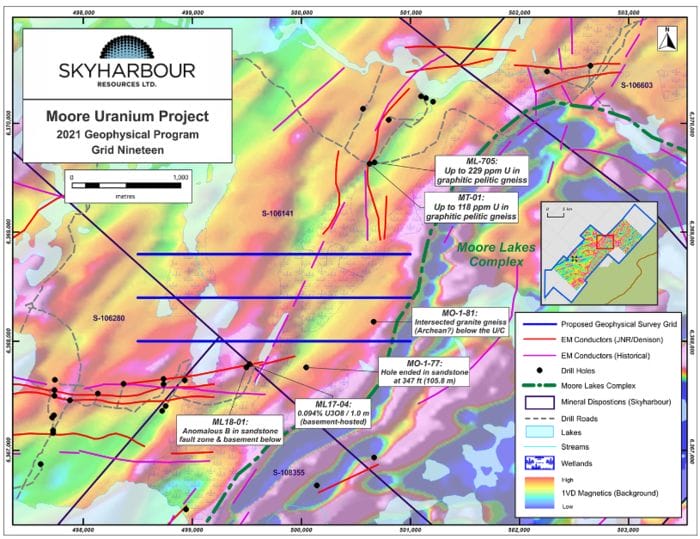 Grid Nineteen represents another significant stretch of prospective ground that has seen only limited historical drill testing—two holes to be precise; one which ended in sandstone and failed to tag the main conductor target.
Grid Nineteen represents another significant stretch of prospective ground that has seen only limited historical drill testing—two holes to be precise; one which ended in sandstone and failed to tag the main conductor target.
Significant discovery potential remains in these subsurface layers.
As noted above, several drill targets at Grid Nineteen were developed via the geophysical campaign conducted earlier this spring. The most accessible of these targets will be drilled during this current campaign.
At the bottom of this June 16th press release, the Company offers a slice of recent history regarding their flagship project.
To summarize…
Skyharbour secured an option to acquire Moore Lake from Denison Mines in 2016. The project consists of 12 contiguous claims totaling 35,705 hectares located 42 kilometers northeast of the Key Lake mill, approximately 15 kilometres east of Denison’s Wheeler River project, and 39 kilometres south of Cameco’s McArthur River uranium mine.
Unconformity-style uranium mineralization was discovered at the Maverick Zone in May of 2000. Historical drill results include 4.03% eU3O8 over 10.0 meters including 20% eU3O8 over 1.4 meters.
In 2017, Skyharbour drilled 6.0% U3O8 over 5.9 meters including 20.8% U3O8 over 1.5 meters at a vertical depth of 265.0 metres at the Maverick Zone (beautiful hit).
“In addition to the Maverick Zone, the project hosts other mineralized targets with strong discovery potential which the Company plans to test with future drill programs. The project is easily accessible by air and in winter via ice roads which simplifies logistics and lowers costs.”
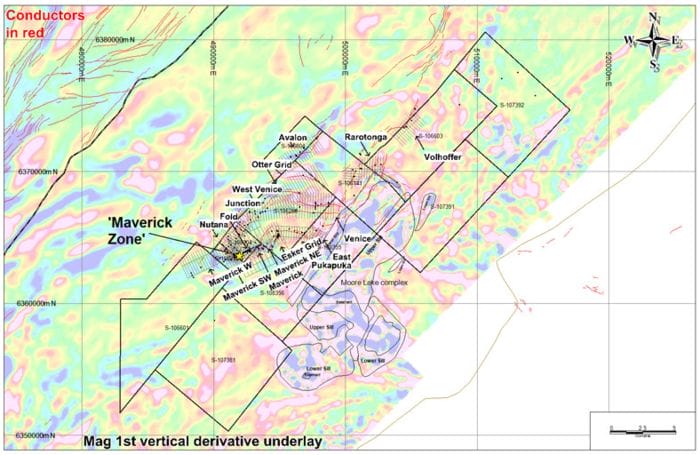 With over C$9 million in cash and equity holdings in its coffers—approx $6.5M in cash and $2.5 in stock—this 5,000-meter campaign is fully funded.
With over C$9 million in cash and equity holdings in its coffers—approx $6.5M in cash and $2.5 in stock—this 5,000-meter campaign is fully funded.
Moore Lake drill results are on deck (only a few weeks off), and with this accelerated program, assay-related newsflow could continue right through into the fall.
Skyharbour’s JV partners will add to the number of meters drilled this year—expect the launch of multiple drill programs over the next seven to eight months.
We stand to watch.
END
—Greg Nolan
Full disclosure: Skyharbour is an Equity Guru marketing client.


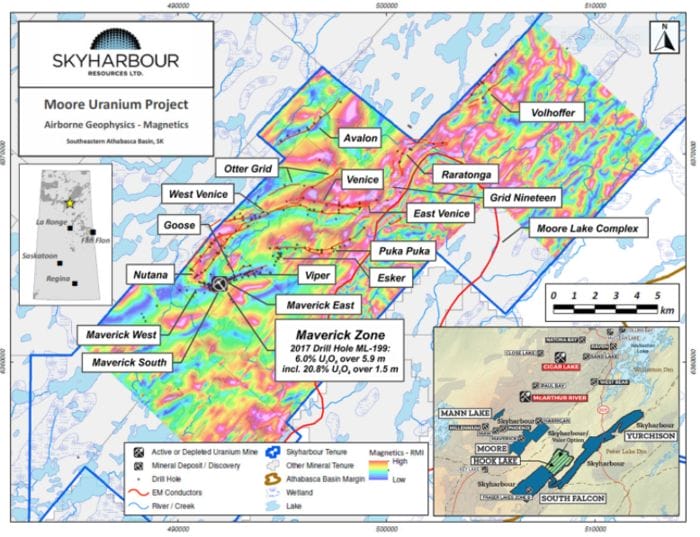 Maverick East Target:
Maverick East Target: